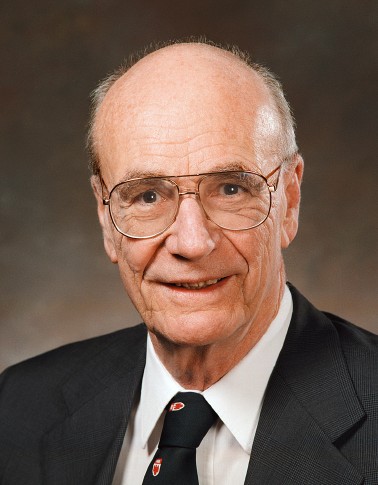You are here
2002 Doggett Prize Winner - Donald E. Osterbrock
Donald E. Osterbrock Awarded the 2002 LeRoy E. Doggett Prize
The Historical Astronomy Division (HAD) of the American Astronomical Society awarded the third LeRoy E. Doggett Prize for Historical Astronomy to Dr. Donald E. Osterbrock for his many books and articles on the history of astronomy. The HAD presented Dr. Osterbrock with the Doggett Prize and he delivered the Doggett Prize Address at the January 2002 HAD meeting in Washington. The following is from HAD News #58 and was written by Ronald Brashear (Photo courtesy Don Harris, UCSC Photo Services):
 Don Osterbrock is Professor Emeritus of Astronomy and Astrophysics at the University of California, Santa Cruz, and former Director of the Lick Observatory. His career in astronomy has been a long and distinguished one. He received his PhD in astronomy in 1952 from the University of Chicago and, after a one-year fellowship at Princeton University, joined the Astronomy Department at the California Institute of Technology and the staff of the Mount Wilson and Palomar Observatories. In 1958 he moved on to the University of Wisconsin, Madison, enjoying a 15-year stay there until 1973 when he became Director of the Lick Observatory. Don Osterbrock was named Professor Emeritus in 1993, and this no doubt gave him more time to pursue his interests in the history of astronomy.
Don Osterbrock is Professor Emeritus of Astronomy and Astrophysics at the University of California, Santa Cruz, and former Director of the Lick Observatory. His career in astronomy has been a long and distinguished one. He received his PhD in astronomy in 1952 from the University of Chicago and, after a one-year fellowship at Princeton University, joined the Astronomy Department at the California Institute of Technology and the staff of the Mount Wilson and Palomar Observatories. In 1958 he moved on to the University of Wisconsin, Madison, enjoying a 15-year stay there until 1973 when he became Director of the Lick Observatory. Don Osterbrock was named Professor Emeritus in 1993, and this no doubt gave him more time to pursue his interests in the history of astronomy.
Don Osterbrock’s interest in the history of astronomy became apparent after his move to Santa Cruz, when a few papers started appearing under his name, including "The California-Wisconsin Axis in American Astronomy," his first historical article, appearing in Sky & Telescope in 1976. Other articles followed, including some on James E. Keeler, a relatively forgotten figure at the time but, as Osterbrock realized, a significant figure in the history of modem astronomy. Osterbrock’s work led to his writing and publication by Cambridge University Press in 1984 of James E. Keeler: Pioneer American Astrophysicist and the Early Development of American Astrophysics. This book not only brought the career of Keeler into focus, but also shed light on the fascinating development of American astrophysics during its formative years and the important part that Keeler played in it before his untimely death in 1900 at age 42.
Don Osterbrock’s use of primary archival resources in his research demonstrated his skill in going beyond a mere recycling of already published information. With the Keeler book, he had certainly made an important historical contribution and, happily, continued on with other research topics. In 1988, with John R. Gustafson and W. J. Shiloh Unruh, Osterbrock authored Eye on the Sky: Lick Observatory’s First Century. Osterbrock then turned his attention to Edwin Hubble as the centennial of that famous astronomer approached in 1989. Together with Joel Gwinn, a physicist at the University of Louisville who had turned up interesting information about Hubble’s time in that city, and Ronald Brashear, curator of the Hubble Papers at the Huntington Library, they managed to show that Hubble’s early years were often quite different than the stories that had been spread and printed about him after his death.
After Hubble, Don Osterbrock’s attention turned to a figure of diminished reputation but of no small importance, George Willis Ritchey. Ritchey’s rise and fall as George Ellery Hale’s telescope expert was followed by his work with Henri Chretien in the development of the coma-free Ritchey-Chretien telescope design, used for every large telescope built or designed since the 200-inch Hale Telescope on Palomar Mountain. Osterbrock’s book, Pauper and Prince: Ritchey, Hale, and Big American Telescopes, was published by the University of Arizona Press in 1993.
After Ritchey, Don Osterbrock turned his attention to the Yerkes Observatory. In Yerkes Observatory, 1892-1950: The Birth, Near Death, and Resurrection of a Scientific Research Institution (University of Chicago Press, 1997), he provided a necessary institutional history of this observatory, a major achievement for American astronomy at the end of the nineteenth century, to its decline after Hale departed for Mount Wilson, and its resurgence under Otto Struve.
Don Osterbrock’s most recent historical book is his biography of Walter Baade, arguably the most influential observational astronomer of the twentieth century. Walter Baade: A Life in Astrophysics (Princeton University Press, 2001), describes an important figure in astronomy, who, due to his lack of interest in publicity, unlike Hubble, remained unknown to the general public. Osterbrock points out what he considers to be Baade’s most important discovery, the two distinct stellar populations: old and young stars. This discovery opened wide the previously marginal fields of stellar and galactic evolution — research areas that would be among the most fertile and exciting in all of astrophysics for decades to come. With this body of work, not to mention all of his other historical journal articles, Don Osterbrock has done much to keep the history of astronomy before the public and is most deserving of the Division’s Doggett Prize.
Professor Osterbrock’s Doggett Prize lecture was titled "The View from the Observatory: History is Too Important to Be Left to the Historians." It was later published in Organizations and Strategies in Astronomy III, ed. by André Heck (Kluwer, Dordrecht, 2002), pp. 201-15. The abstract appeared in Bull. Am. Astr. Soc. 33, no. 4.
